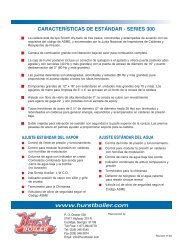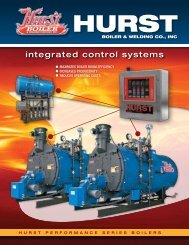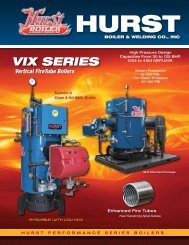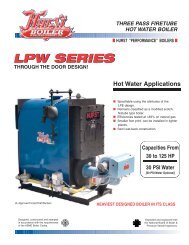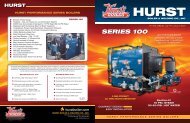Component & System Guide - Hurst Boiler
Component & System Guide - Hurst Boiler
Component & System Guide - Hurst Boiler
Create successful ePaper yourself
Turn your PDF publications into a flip-book with our unique Google optimized e-Paper software.
H U R S T B O I L E R S E R I E S “ M H ”<br />
GASIFICATION / COMBUSTION PROCESS<br />
The <strong>Hurst</strong> combustion system has been specifically designed to gasify the biomass fuel<br />
in the lower portion of the furnace (gasification region) with ignition of the generated<br />
fuel gas occurring in the upper portion (combustion region), in close proximity to the<br />
water walled hybrid boiler section located immediately above the furnace, to make<br />
efficient use of the radiant heat component of combustion. This equipment<br />
arrangement is more efficient than using a stand-alone gasifier, producing “syn-gas”,<br />
because a STAG unit is note designed to recover radiant heat. This process has been<br />
legally designated as close-coupled gasification by the I.R.S. for previous tax credit<br />
purposes.<br />
The process begins with the<br />
entrance of the fuel into the<br />
furnace area. See, Fuel Feed<br />
<strong>System</strong> for a detailed<br />
description of the fuel system<br />
and its components. The<br />
lower portion of the furnace<br />
(gasification chamber) with<br />
its grates has been designed<br />
to function with an<br />
inventory/pile of fuel at all<br />
times. The pile is required to Figure 9 Combustion chamber front view<br />
not only provide the fuel to<br />
meet demand but act as a cushion between the hot surface of the fuel and the grates.<br />
Insufficient pile depth will damage the grates. As the fuel is forced into the retort<br />
it displaces existing fuel that spills over the cast iron grates, and onto the pinhole grates<br />
--- in units that have them --- through which under grate/gasification air is forced. The<br />
decomposition of the fuel (pyrolysis), due to the heat at this point occurs.<br />
The furnace is maintained at a negative pressure, -¼“ Water Column (W.C.). to -1¼”<br />
W.C., by an Induced Draft (ID) fan that is controlled by a photohelic controller.<br />
Maintaining the furnace at below atmospheric pressure avoids “blow back”, a<br />
potentially dangerous condition. The furnace (and stoker zones in some cases)<br />
temperature is also monitored. A k-type thermocouple is inserted into the refractory<br />
11<br />
Chapter<br />
3



